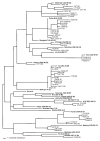Molecular epidemiology of measles viruses in the United States, 1997-2001
- PMID: 12194764
- PMCID: PMC2732556
- DOI: 10.3201/eid0809.020206
Molecular epidemiology of measles viruses in the United States, 1997-2001
Abstract
From 1997 to 2001, sequence data from 55 clinical specimens were obtained from confirmed measles cases in the United States, representing 21 outbreaks and 34 sporadic cases. Sequence analysis indicated the presence of 11 of the recognized genotypes. The most common genotypes detected were genotype D6, usually identified from imported cases from Europe, and genotype D5, associated with importations from Japan. A number of viruses belonging to genotype D4 were imported from India and Pakistan. Overall, viral genotypes were determined for 13 chains of transmission with an unknown source of virus, and seven different genotypes were identified. Therefore, the diversity of Measles virus genotypes observed in the United States from 1997 to 2001 reflected multiple imported sources of virus and indicated that no strain of measles is endemic in the United States.
Figures

References
-
- Rota JS, Heath JL, Rota PA, King GE, Celma ML, Carabana J, et al. Molecular epidemiology of measles virus: identification of pathways of transmission and the implications for measles elimination. J Infect Dis. 1996;173:32–7. - PubMed
-
- Centers for Disease Control and Prevention. Measles—United States. MMWR Morb Mortal Wkly Rep. 2000;49:557–60. - PubMed
-
- Chibo D, Birch CJ, Rota PA, Catton MG. Molecular characterization of measles viruses isolated in Victoria, Australia, between 1973 and 1998. J Gen Virol. 2000;81:2511–8. - PubMed
MeSH terms
LinkOut - more resources
Full Text Sources
Medical
